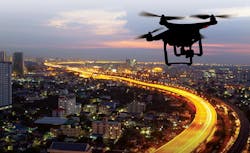Department of Homeland Security surveys industry for bistatic radar to detect and track unmanned aircraft
WASHINGTON – U.S. Department of Homeland Security (DHS) researchers are surveying industry for stealthy bistatic radar systems able to detect and track small unmanned aircraft, with enabling technologies ranging from prototypes to flight-proven systems.
Officials of the DHS Office of Procurement Operations (OPO) in Washington issued a request for information (70RSAT23RFI000011) earlier this month for the Passive Radar Systems for Detecting and Tracking Small UAS project.
Bistatic radar seeks to conceal the locations of radar transmitters and receivers by processing RF and microwave reflections from commercial broadcast and communications signals, as well as from other non-cooperative sources of illumination.
The capabilities of today's small unmanned aerial vehicles (UAVs) are advancing more quickly than the ability to defeat them, officials point out. DHS wants to learn more about the availability of bistatic radar to detect and track these small unmanned aircraft.
Related: New frontiers in passive radar and sonar
From industry, DHS officials want information about unmanned aircraft-detecting bistatic radar performance; costs; mobility and maneuverability; level of maturity; system size, weight, and power consumption (SWaP); detection and tracking range; time to deploy and calibrate; and number of operators required.
Companies interested should email responses no later than 9 April 2023 to [email protected], with 70RSAT23RFI000011 in the subject line. Submissions with sensitive or proprietary information are discouraged.
Email questions or concerns to DHS at [email protected]. More information is online at https://sam.gov/opp/dc03960af9464cdd8013e4570d6b2bd7/view.
About the Author
John Keller
Editor-in-Chief
John Keller is the Editor-in-Chief, Military & Aerospace Electronics Magazine--provides extensive coverage and analysis of enabling electronics and optoelectronic technologies in military, space and commercial aviation applications. John has been a member of the Military & Aerospace Electronics staff since 1989 and chief editor since 1995.
